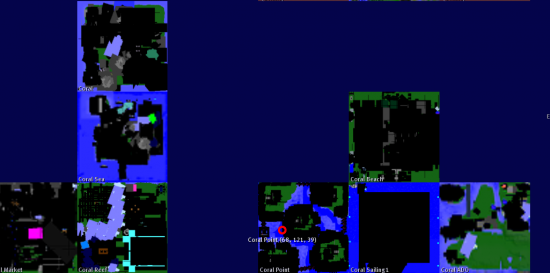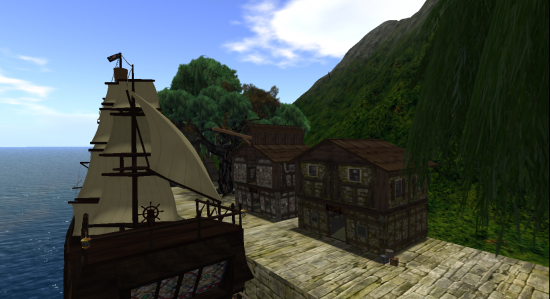Business users choosing virtual environments usually focus on particular features — does it support mesh imports? Are there in-world editing tools? How good is the voice? Is the a web viewer?
However, most of these features are time-dependent — eventually, every virtual world platform is going to have mesh imports and a web-based viewer, and all the platforms are improving their voice capabilities and in-world editing tools.
However, there is one feature, often overlooked, which is permanent and directly affects the user experience: whether the world is based around rooms connected by portals, or regions located on a grid. In fact, most people don’t know the difference between the two, or why they should care — but it dramatically changes their experience of a world.
As far as developers are concerned, room-based worlds are more elegant. A room can be any size and can be connected to any other room. Rooms make it easier to implement security features, and allow infinite flexibility when it comes to virtual world design.
Developers are also used to the room metaphor — this is how the early dungeon games were designed. Chances are, many learned to program databases by creating room-based adventure games.
By comparison, a grid-based, map-style architecture where every region is a fixed size seems like a clunky cludge.
But, in practice, things aren’t so simple.
A region with a view
A region on a grid is like a square on a checkerboard, with each square 256 meters on a size — or 16 acres in virtual area.

Every region is composed of land, water — if the terrain is below the water table — and all the air above it. Buildings can be placed on the land — or under water — or even set floating in the air. If two regions are right next to each other, you can walk, swim or fly between them.
The net effect is that the virtual world feels a lot like the real one. When you walk outside, there’s a breeze blowing through your hair, the trees sway, and there are clouds floating across the sky.
If you fly up into the sky, you can see the clouds up close — and look down on wide open stretches a land. The more powerful your computer, the farther you can see.
A room of your own
With room-based worlds, each room is a box floating around in empty space. You can’t walk or fly of the room even if you wanted to — there’s nothing outside it. The only way to teleport out is by using a portal.
A room can be as small or as large as your computer can handle. That means that you can make a room as large as your city, paint the ceiling to look like the sky, and paint the walls to look like the horizon. But if you got close enough, you’d see that it’s painted on.
Typically, you can’t see from one room into another room, since they’re not actually located next to one another. However, some vendors can create portals — in the form of doorways and windows — that users can see through, as well as walk through.
Not having the ability to see into the room next door can also be a security advantage. There’s no chance that someone will eavesdrop on a sensitive conversation or get a glimpse of top-secret financial reports by standing close by and panning their camera through the walls.
Meanwhile, companies can do interesting things with teleportation portals. For example, you can make your teleportation portals in the shape of doorways. Someone walks through a doorway and — poof! — they’re teleported to another room.
So you can start in one room, walk to the other side, teleport to a second room, walk to the other side, then teleport back to the first room where you started out. Creepy! Like one of those horror films, where you try to escape from a house, but every new door just takes you back to a room where you’ve already been.
Or you could make a room look like a large corporate campus, with many tiny buildings in it, and the ceiling painted to look like the sky. When you walk through a doorway into one of these buildings — which look small from the outside — all of a sudden you’re inside a giant conference center.
If you’re a fan of Dr. Who, this is how the Tardis works — it’s bigger on the inside than the outside.
All of these special effects are fun and cool for science fiction fans, and for programmers.
But they can create problems for the average user.
First of all, it’s hard to create a mental map of a virtual environment where everything can connect to everything else and things are bigger on the inside than the outside. That makes it hard for people to find their way around.
Second, each time a virtual world ignores the laws of physics, it reminds the users that they’re not in a real place, that they’re in a made-up location inside a computer. It interferes with the suspension of disbelief that makes it possible for team members to feel that they are “really there” next to their colleagues, sharing experiences, and building trust.
The convergence
To some limited degree, room-based worlds can be made to look like grid-based worlds, and vice-versa.
For example, with careful planning, you can create a room-based world where the rooms are geographically contiguous and users can walk between them in logical ways.
With grid-based worlds, you can create minigrids and connect them with hypergrid teleportation portals, so that every mini-grid is otherwise completely isolated from the others.
In OpenSim, you can also create megaregions — regions the size of four, nine or 16 regular regions. Megaregions do away with the border crossings that can sometimes trip up virtual pedestrials and make it easier for vehicles to carry people around.
However, there is a limit to what can be done. The map metaphor of grid-based worlds means that regions can’t be arbitrary in shape — otherwise, they wouldn’t be able to fit in next to the other regions on the map.
It also is extremely difficult to create the effect of the wide open outdoors in a room-based environment, for example.

Grid-based platforms
Second Life, OpenSim, realXtend
Room-based platforms
ProtoSphere, Teleplace, VastPark, Olive
- Kitely Mega Worlds on sale for $90 per month - July 19, 2024
- OpenSim regions up, actives down with summer heat - July 15, 2024
- People think AIs are conscious. What could this mean for bots in OpenSim? - July 12, 2024
